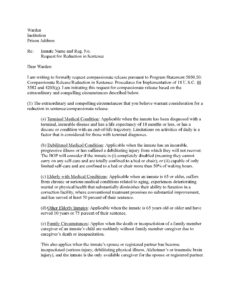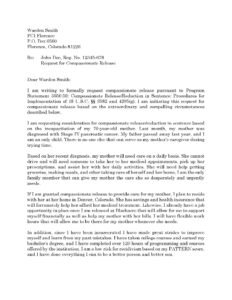Share
Share

Sample Compassionate Release Letter: The Basics
The best compassionate release lawyers understand that cases can be won or lost from the very start. Beginning the compassionate release process in federal prison requires looking to the law under 18 U.S.C. Section 3582(c)(1)(A). Compassionate release lawyers for federal inmates know that it all starts with the compassionate release letter.
The experienced compassionate release attorneys at Evergreen Attorneys know that a great lawyer can make the difference between hope and despair. Before we get into the specifics of a sample compassionate release letter, it’s important to understand the background of compassionate release.
Compassionate release: why even bother?
Imagine spending your final days of life not in a hospital bed surrounded by loved ones, but in a cold prison cell: frail, terminally ill, and alone. One man, 80 years old, can barely stand without assistance. He’s battling stage IV cancer, uses an oxygen tank, and hasn’t posed a threat to anyone in decades. And yet, he remains behind bars, serving out a sentence that no longer makes sense—not to his doctors, not to his family, and not to common sense.
Stories like his are at the heart of a growing conversation about compassionate release: a legal mechanism which provides incarcerated people the chance to live the remainder of their life with dignity. But often, that compassion arrives far too late—if at all. Evergreen Attorneys take great pride in fighting for compassionate release for federal prisoners. We work everyday to be the best compassionate release lawyers in the country.
Basics of compassionate release
Compassionate release is the legal provision allowing the early release of inmates due to “extraordinary and compelling reasons,” which will be more precisely defined later. Commonly, these circumstances include old age, serious disability, or severe illness. Essentially, this practice ensues when an individual’s imprisonment is no longer serving a meaningful purpose (e.g., protecting public safety or preventing further offending), and compassion, dignity, and basic human decency are prioritized instead.
This form of release is sometimes referred to as:
- Medical release
- Elder parole
- Reduction in sentence (RIS)
- Humanitarian release
Despite the varying terminology, the underlying principle remains the same: compassionate release allows courts to give a second look at sentences which are not fair today. Compassionate release is a last chance at hope. Evergreen Attorneys believe in hope for everyone who is incarcerated in federal prison no matter the case.
First Step Act and Compassionate Release
Old Law: Jailer is in charge of the keys to compassionate release
Although the Sentencing Reform Act of 1984 abolished parole for federal prisoners, it created compassionate release, which was codified under 18 U.S.C. § 3582(c)(1)(A). This law permitted the reduction of an inmate’s sentence for “extraordinary and compelling reasons,” but the Federal Bureau of Prisons (BOP) had to file the motion on the prisoner’s behalf. The jailer had to ask the courts to let its prisoners go. I wonder how well that worked out?
The issue with the original statute was two-fold: 1) the BOP acted as the gatekeeper for compassionate release requests and 2) it almost never used that power. According to a report from the U.S. Department of Justice, from 2006 to 2011, an average of only 24 prisoners were released annually through compassionate release.
With a federal prisoner population of approximately 218,000 at the time of publication, that’s equivalent to just 0.011% of inmates. Additionally, the DOJ admitted 13% of prisoners “whose requests were approved by both a Warden and Regional Director during the period of our review died before the BOP Director made a decision on the request.”
2018: First Step Act Opens Compassionate Release Gates
Eventually, the First Step Act (FSA) was passed in 2018 and changed 18 U.S.C. § 3582(c)(1)(A), which subsequently increased access to compassionate release. Rather than having to solely depend upon the motion of the BOP, the FSA amended the original statute “to allow a defendant to file a motion seeking compassionate release directly in federal court after satisfying an administrative exhaustion requirement.” Before submitting this request to the court, the inmate must first make a request to the BOP and wait 30 days.
There FSA had several major impacts, including:
- Removing the bottleneck that was known to block legitimate petitions for compassionate release, streamlining this process.
- Giving judges the power and discretion to independently evaluate compassionate release cases.
- Opening the door to a broader interpretation of “extraordinary and compelling reasons.” Previously, the BOP had limited and strict criteria for meeting these circumstances, often tied only to complete incapacitation or imminent death. The United States Sentencing Commission has subsequently amended the applicable policy statement under 1B1.13 greatly expanding the definition of that phrase.
Extraordinary and Compelling Reasons for Compassionate Release
The United States Sentencing Commission (USSC) is delegated the authority to determine what is an “extraordinary and compelling reason” to merit compassionate release. The only statutory restriction on that authority is that rehabilitation alone cannot be an extraordinary and compelling reason. According to the USSC’s Policy Statement §1B1.13, these circumstances fall under the following six categories:
- Medical circumstances of the defendant
- Age of the defendant
- Family circumstances of the defendant
- Victim of abuse
- Other reasons
- Unusually long sentence
Medical Circumstances
Various health factors of the inmate qualify as “extraordinary and compelling reasons” for compassionate release. Examples include an individual who is battling a:
- “Terminal illness”
- “Serious physical or medical condition”
- “Serious functional or cognitive impairment”
- “Deteriorating physical or mental health” issue
In addition to the medical condition itself, the USSC accounts for the health care and treatment necessary for the condition. More specifically, if the correctional facility is unable to appropriately provide the necessary medical care for an inmate, that could be considered a qualifying reason for a reduction in term of imprisonment. Furthermore, if a prisoner is particularly at risk of contracting an infectious disease or developing health complications while being housed in prison, this could serve as another justification for compassionate release.
Age of the Defendant
Another “extraordinary and compelling reason” considered is the age of the prisoner. An inmate may qualify for compassionate release if he or she:
- “(A) is at least 65 years old; (B) is experiencing a serious deterioration in physical or mental health because of the aging process; and (C) has served at least 10 years or 75 percent of his or her term of imprisonment, whichever is less”
Family Circumstances
Compassionate release isn’t just for medical issues and emergencies—it can also apply when a person’s family needs them in a way nobody else can fill. These instances include:
- The death or serious incapacitation of the caregiver of the prisoner’s minor child, or of an adult child with a serious disability who cannot care for themselves.
- The incapacitation of the prisoner’s spouse or registered partner, when the prisoner is the only one available to care for them.
- The incapacitation of the prisoner’s parent, where he or she would be the sole available caregiver.
- If the prisoner has a relationship with another close family member (grandparent, sibling, grandchild) akin to that of immediate family and is involved in similar circumstances, and the prisoner is the only available caregiver.
In each of these situations, the common denominator is that nobody else is available to provide the necessary care, and the condition of the family member in need is serious enough to require such care.
Victim of Abuse
Another recognized basis for compassionate release involves experiences of serious abuse while in custody. A person may qualify if they were the victim of:
- Sexual abuse (involving any sexual act, as legally defined) and/or
- Physical abuse (that resulted in serious bodily injury)
Additionally, the abuse must have been committed by (or at the direction of) a:
- Correctional officer
- Prison employee
- Contractor
- Or anyone else with authority over the inmate while incarcerated
Generally, unless the following processes are delayed or the victim is in imminent danger, the abuse must be proven through one of three ways:
- A criminal conviction
- A civil judgment or admission of liability, or
- An administrative finding
By including abuse victimization as a type of “extraordinary or compelling reason,” especially at the hands of those in power, the law recognizes that abuse can create circumstances so extraordinary that continued incarceration becomes unjust.
Other Reasons
As denoted in §1B1.13, other reasons for compassionate release include “any other circumstance or combination of circumstances that, when considered by themselves or together with any of the reasons described in paragraphs (1) through (4), are similar in gravity to those described in paragraphs (1) through (4).” [Paragraphs (1) through (4) in this policy explain the previously discussed medical circumstances, age, family circumstances, and abuse.]
Unusually Long Sentence
Finally, some people serving long federal sentences are behind bars not because they’re dangerous, but because they were sentenced under laws or policies that have since changed. Under §1B1.13’s updated compassionate release guidance, a court may now consider a disproportionately long sentence as part of the “extraordinary and compelling reasons” for release, but only under specific conditions.
To qualify:
- The person must have already served at least 10 years of their sentence.
- There must have been a change in the law.
- That change must now create a major gap between the sentence the person is serving and what they likely would receive if sentenced today.
- The court must also consider the person’s individual circumstances (e.g., rehabilitation, conduct in prison, and reentry readiness).
It’s important to note that this does not apply to changes in the Sentencing Guidelines, unless those changes have been made retroactive—that is, officially approved to apply to individuals already serving their sentences. There is currently a lot of litigation among the U.S. Courts of Appeals about the “unusually long sentence” and “other reasons” provisions being potentially unenforceable. We will cover that circuit court split in a separate post in the near future.
Asking for compassionate release: it’s in the letter, my friend!
Filing for compassionate release in the federal system involves several legal and procedural steps. Here is how the process typically works:
- Submit a request to the BOP warden
- Wait 30 days
- File a motion in federal district court
- Read the Government’s response in opposition
- File a reply (if authorized by local rule)
- Present evidence at a compassionate release hearing if granted by the judge
- Receive the judge’s decision granting or denying compassionate release
The first step is to submit a written request (compassionate release letter) to the warden (the individual in the highest position at the prison) of the correctional facility where the person is incarcerated. This can simply be addressed to the warden and can be either submitted by the inmate directly or by someone on the outside on their behalf (like an attorney).
The compassionate release letter must explain the “extraordinary and compelling reasons” for release, in addition to the proposed release plan to be followed once released. The plan should outline details for expected housing, medical care, and community support.
18 U.S.C. § 3582(c)(1)(A) mandates that the prisoner must either wait 30 days after submitting the request or receive a denial before proceeding in court. So it is important to get the compassionate release into the warden quickly to start the 30 day clock ticking.
The Important First Step: Writing the Letter and Sample Letters
The written request to the BOP warden is more than just a procedural formality—it is the first and most critical opportunity to make the case for compassionate release. Here is why it matters:
- It starts the entire legal process.
- As explained earlier, an incarcerated person cannot file a motion with the court until they have completed this step and either waited 30 days or received a formal denial.
- It sets the narrative.
- This letter is often the first impression of the case.
- A well-crafted request clearly explains the “extraordinary and compelling reason(s)” for release, includes facts, presents a concrete release plan, and shows the individual’s growth (rehabilitation, character, readiness for reentry).
- It can influence the government’s position.
- Although the court has the final say, the BOP and U.S. Attorney’s Office review the original request to the warden, whose stance may sway the court decision.
- A strong, clear, and respectful request can help build credibility early in the process.
- It helps avoid delays.
- If key details are missing (e.g., medical documentation, release plan, explanation of family circumstances), the request may be rejected or ignored.
- By including these details right away, the process can be streamlined, avoiding long periods of waiting or having to resubmit the request.
Overall, the initial letter to the warden is a legal and strategic foundation. It’s the first chance to show that the request isn’t just compassionate—it’s well-prepared, justified, and ready to be taken seriously.
Compassionate Release Letter Template
Evergreen Attorneys have assisted dozens of federal inmates with seeking compassionate release. Below you can find a template for a letter to the warden that your loved one can customize to their circumstances. This compassionate release template is just a starting point of course. You will need to make the template specific to your loved one’s case, include a release plan, and describe why they should get compassionate release:
We recommend hiring an experienced Colorado compassionate release attorney to help craft the best letter to the warden. But sometimes, we know folks just cannot make that happen.
Compassionate Release Warden Letter Example
Below you can find an example letter that describes the circumstances of a more real compassionate release inmate. We are providing this redacted letter to the general public so that you can see a 30,000 foot example of what the compassionate release attorneys at our law firm put together.
We pride ourselves on not performing cookie-cutter work as compassionate release lawyers. We believe that our dedication and hands-on approach as a small, boutique compassionate release law firm shines in the work we do for our clients. Here is an example compassionate release letter to the warden you can view:
Denver Federal Compassionate Release Attorneys
Take Action today if you need a federal compassionate release lawyer
If your loved one is incarcerated and needs hope, don’t hesitate to see if they qualify for compassionate release. Contact Evergreen Attorneys today for a confidential consultation. We’re here to help you understand your options and build compelling case for compassionate release to bring your loved one home. You may also call us at 303-948-1489 or email us at [email protected] to get in touch with an experienced federal lawyer at Evergreen Attorneys today.
Zachary Newland
Zachary Newland is an attorney, author, aspiring BBQ connoisseur, and mediocre skier. Zachary's law practice is focused on federal criminal defense, federal appellate advocacy including post-conviction remedies, civil rights litigation, and complex trial work. Zach lives in Evergreen, Colorado with his family. You can reach Zach at [email protected] to discuss your case or call him directly at 303-948-1489.
STAY IN THE LOOP
Subscribe to our free newsletter.
Federal Sentencing Lawyers A conviction [...]














